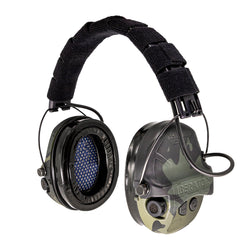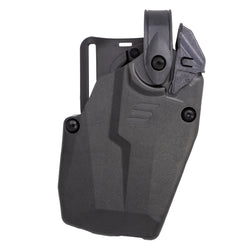The .45 ACP is an all-American cartridge with a track record in war and peace going on 120 years. While the cartridge is most associated with the 1911 platform, it is found in firearms ranging from small, polymer-framed subcompact pistols to pistol caliber carbines.
But the 9mm Luger has now supplanted it to become the most popular pistol cartridge in the United States. That begs the question: why did the .45 ACP decline, and does it have any relevance today?
Where the .45 ACP Began
Long before expanding hollow point ammunitions, bigger bore guns were rightly perceived as more effective. Greater mass translates to more momentum on the target, even at relatively low velocities. You get more penetration and better downrange ballistics. And generally, the bigger the mass the bigger the bore and the bigger the hole in your target.
When the US Army went to its first revolver in the late 1840s, the .44 caliber bore was preferred over competing .36 caliber guns for its propensity to put down horses as well as men. That propensity carried over when the Army went to the cartridge-firing Colt Single Action Army revolver chambered in .45 Colt.
The US Cavalry experimented with the break-action Smith & Wesson Schofield, and to simplify logistics, the M1881 ball cartridge was developed to suit both revolvers. It used a .45 caliber 230 grain lead slug traveling at about 850 feet per second.
Eventually, the Army went with a lighter, quicker shooting .38 caliber revolver in the Colt M1892, but power problems in combat during the Philippine-American War caused the Army to go back to the .45. The new .45 ACP cartridge had arrived with a new Colt pistol in time for the 1905 pistol trials. The cartridge itself was developed by John Browning to duplicate the M1881 ball round’s ballistics but with a jacketed bullet, smokeless powder, and a rimless case to function reliability in an automatic pistol.

Though this cartridge and gun combination did not pass muster compared to the .45 Colt New Service revolver, it legitimized the semi-auto platform as a contender. The improved Colt Model 1911 in .45 ACP handily beat the competition to become the Army’s official sidearm that year. The Model 1911 was offered for civilian sale shortly afterward.

The .45 ACP is closely associated with the Second World War and its use in the M1911 pistol and submachine guns like the M1 Thompson and the M3 Greasegun. But in the decades since, the popularity of the .45 ACP has faded.

Good Round, Bad Round
The .45 ACP has all been supplanted by the 9mm Luger for a number of reasons. 9mm Luger, at least on paper, has an equivalent amount of power. Its use by the US military and NATO gives ammunition manufacturers true economies of scale to produce the ammo for a ready market, making it cheaper to buy. The 9mm, in an equivalently sized handgun or carbine, will almost always give you more ammunition capacity.
While the landscape, the guns, and the ammunition have changed for 9mm Luger, the .45 ACP is not idle. Indeed, while it is easy to make a case against the .45, there is still a case for it.
The Case Against .45 ACP
The .45 ACP is a large pistol cartridge with a longer and bigger case and bullet compared to rounds like 9mm Luger and .40 S&W. Its size is part of the appeal of the round, but it is also the primary detriment. That big round also takes up more room in a magazine. In any given pistol or PCC platform, the version in .45 ACP is going to have a lower magazine capacity.
In a traditional platform like a single-stack 1911, the .45 ACP version generally holds seven or eight rounds, where a version in 9mm would hold nine or 10. Small compact pistols like the Springfield XDs hold eight rounds of 9mm and only six rounds of .45.
It takes a larger framed handgun for the .45 ACP to compete on a more-or-less level playing field with other service cartridges. Pistols like the CZ P10 .45, Glock 21, and FNX-45 offer double-digit capacity, but they are physically larger handguns compared to their 9mm counterparts. Given that modern 9mm and .45 ACP, on paper, you might prefer the 9mm, given you have more rounds in the pistol or carbine overall.

The gravitation toward 9mm is not just about capacity. Despite both the 9 and 45 having similar energies, how they impart that energy both to the target and to the shooter varies. In the case of the shooter, that means felt recoil and muzzle rise between shots, as well as the time it takes to realign the sights for the next shot.
In the recoil department, the .45 ACP has more recoil than an equivalent handgun compared to the 9mm. However, the slow-moving and lower-pressure .45 generates less sharp of a recoil impulse, though muzzle rise is more. The 9mm is a higher velocity round with a sharper recoil impulse, but that is offset by overall less muzzle rise, allowing for somewhat quicker recovery.
The Case for The .45 ACP
All things being equal, if the 9mm Luger generally delivers good performance and you get more rounds in a given platform with less felt recoil, why bother with the .45 ACP? It can be tempting to make an affirmative case for the .45 such as, “9mm might expand but .45s do not shrink.” That is certainly true.
The wider starting diameter of the .45 allows for a greater chance for damage to vital systems, but a poor shot with a .45 is no more effective than the alternatives. In fact, in real-world shootings, the difference can be surprisingly marginal.
Greg Ellifritz’s excellent study, An Alternative Look at Handgun Stopping Power, does show the .45 as being more effective than the 9mm. Across all ammunitions, the .45 has a one-shot stop percentage of 39% and an average of 2.08 shots were needed for ending a fight.
One round of 9mm ended the threat 34% of the time, with an average of 2.45 rounds needed. While the .45 ACP is a demonstrated fight stopper, the statistics can be misleading given the sheer volume of the sample size for the 9mm. Power is not and should not be the only reason for considering the .45.
A more convincing case to be made is that, while 9mm has come a long way, so has .45. All those advances have extended to .45, but the history is more of a case of other rounds catching up than .45 regressing. Modern hollow-points, double-stack magazines, and polymer frame pistols are had in .45; it just happens that 9mm is more popular at this time. But you need not make the affirmative case for the .45, but a negative case for the alternatives.

The case for the .45 is often a case against another round. .40 S&W is on its way out in terms of popularity, and it has a reputation for wearing out handguns prematurely. Modern 9mm, particularly with +P loadings, can also do so. Ergo, the lower-pressure .45 looks good if you like longevity.
Another higher-pressure round that has rebounded in popularity is the 10mm Auto cartridge. The 10 is increasingly popular for outdoor applications and is readily chambered in firearms developed for the .45 ACP. Despite its power, though, the longer 10mm is less reliable when cycling through auto pistols compared to the shorter .45. For close-range hunting and wilderness defense, one might opt for a controlled expansion or hard cast .45 round
The .45 ACP in hard ball configuration produces decent performance compared to 9mm. That might make the difference if you live in a jurisdiction where hollow-point ammunitions and magazine capacities are still regulated. The .45 also excels in a suppressed platform as it is naturally subsonic in most loadings. Most 9mm rounds are supersonic, and even some 147 grain rounds advertised as subsonic will break the sound barrier.
The .45 ACP: Will It Keep Going?
The .45 ACP has seen quite a few ups and downs since its introduction. The basis for its existence is subject to myth and conjecture, but the .45 ACP has become a byword for effectiveness.
Other cartridges have come on the scene and made great strides in the effectiveness department. These developments were strong enough for shooters to look at the faults of the .45 that were once readily ignored. But changes in ammo and firearms also extend to the .45, and a case for the cartridge is still easy to make.
The .45 ACP will continue on, so long as the popularity of the 1911 and nostalgia for all things “big bore” holds on. That is a shame, as today’s .45s are not like your granddaddy’s. If there is one cartridge due for a renaissance, the big fat .45 is a strong candidate.









